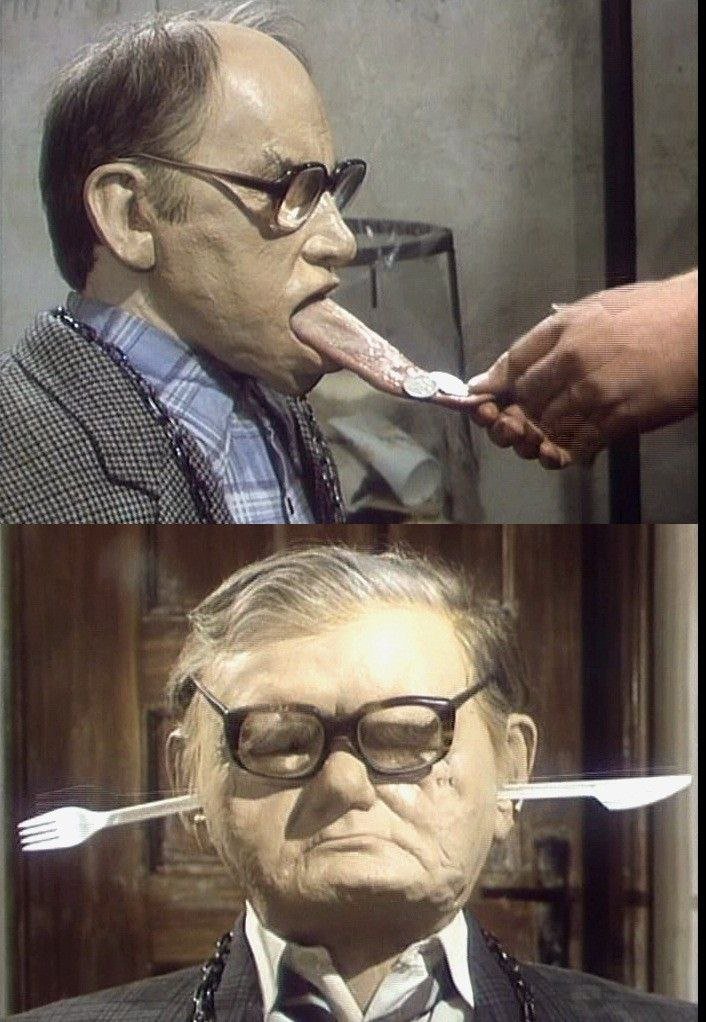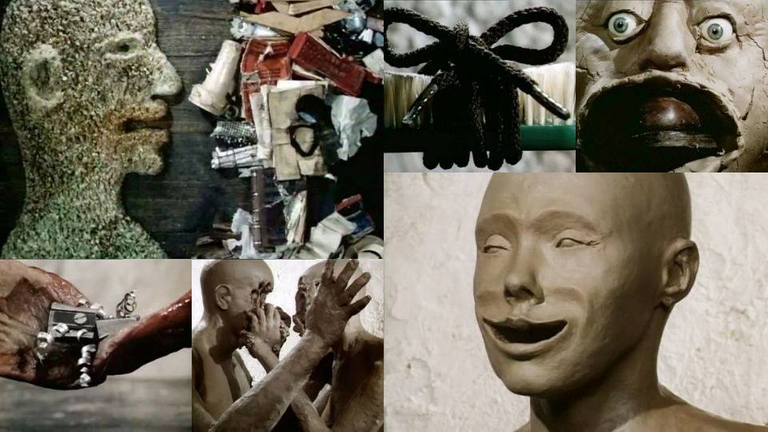
Jan Svankmajer's imagination has an unnerving quality to it, and surrealism adds fuels to that fire. His use of stop motion along with live action footage are often so bizarre and unsettling that, the audience is tricked by the actions on the screen, prioritizing the visual extravagance, not what they imply. I'm not out of that crowd either. This is why I want go back to his films to read between the lines. Let us examine two of his short films.
Food (Jídlo) (1992)

Food has three acts, Breakfast, Lunch and Dinner. Švankmajer uses each act to make allegorical implications of human behavior and state of relationships.
In the breakfast act, we see a man enters into a small room, where another one was seated like a machine. The newcomer reads some instructions written on a board hanged on the other man's neck and follow them to procure food. He performs all sorts of mechanical abuse on the man to get it. Once his meal ends, he turns into the food machine, the seated comes man leaves, he becomes the new seated man and a new man enters to take his meal—repeating the same procedure all over again.
I took it as primarily as a reference to social conduct. Each man is out for themselves and trying to extract as much as they can from the other person, following the very same ideas that have been around since time immemorial. Another interpretation can be that, Švankmajer is ridiculing the mechanical way of life and how comfortable people have become relying on them, without realizing the process has turned them into machines as well. I lean towards my first theory more.
The second act, at lunch, we see two people sitting at a restaurant table. One of them is bourgeoise with all the expected manners and the other one is a simpleton, a poor commoner. But when the waiter doesn't serve them anything, it is the bourgeoise who starts to eat the flower, table cloths and every inedible object in sight. The poor follows him suit.
While this bizarre devouring of inedible things have adequate comedic charm to it, I believe it bears a significant meaning. The blind following of the rich by the poor, their way of life, their whimsical habits—forfeiting all common sense and getting screwed in the end.
In the third act, dinner, a person is seen seasoning their food with any number of sauces, spices and they never seem to end. As if through the process, they're attaining some sort of greatness. But when they are done seasoning, we see they have part of a human flesh on their massive plate. Likely, of the poor man who was at lunch.
I interpreted the third act as an allegory of grotesque extravagance of the rich bourgeoise at the expense of the poor.
Of course, the film is open to interpretation, I've never seen any official explanation of it. So individual experiences with the movie will vary a lot.
You can see the full film here -

Dimensions of Dialogue (1983)

Different objects, food items are arranged in a way that they appear as tangible shapes. This is called arcimboldo style, named after the initiator. In this film, Švankmajer uses arcimboldo, but he takes it a step further, animates it with the stop motion technique.
In the first act, similar objects make up head like shapes and then they engage in battles with each other. Head made with food items attack head made of pens, papers and the like. Pens, pencils attack head of nuts and bolts. After repeated attacks, all the things turn into unrecognizable junk and lose their inherent type, their uniqueness.
Perhaps, this is an allegory of disappearance of the individual in social structures that force them to go through meaningless generalization. This could also be targeted at class distinction.
In the second act, a couple—a man and a woman, both made out of clay—engages in lustful intercourse. A indescribable entity is born out of their union, which slowly turns into the object of bitter, violent dispute between them.
I took it as an allegory of psychological states of people before and after formation of relationships. Specially when they find out stuff they don't like about each other. Ahem, I suppose we've all experienced this!
The third act has two heads, claymade. At first both of them sprout compatible objects and all is good. But then they start sprouting incompatible and downright destructive objects. The more they do it, the more they cause mayhem and decay!
I'm sure I can fit this one in any number of scenarios, incompatible ideologies being the obvious.
You can see the full film here -
Have you seen these films? If you did, did you interpret them differently? I'd love to know any insight!
All the photos attached are screenshots from the films



Congratulations @notacinephile! You have completed the following achievement on the Hive blockchain and have been rewarded with new badge(s) :
Your next target is to reach 1500 replies.
You can view your badges on your board and compare yourself to others in the Ranking
If you no longer want to receive notifications, reply to this comment with the word
STOPCheck out the last post from @hivebuzz:
I really like svankmajer! Great director. I had the pleasure of meeting you in my teens when I was watching movies stoned, haha. There were moments of incredible contemplation of this surrealism that only he is capable of!
Indeed! He's one of my favorites as well! Fascinated me from time to time. :)
I think I was stunned for about 2 or 3 minutes before I could say a word when I watched Food... thanks to you
You're welcome. 😛
Well, you'll want to see more of him in future!
That looks so bizarre that I may just have to take a look!
It is quite bizarre! I'm sure you'll love it. Happy watching!
We saw the food together! Thanks!
Without you, I would have never known that film exists!
You're welcome!
That's the thing, there are great movies that remain in the dark, unknown for the most part. I want interested and sensible people to experience them. Perhaps, cinetv will be a good opportunity for me. :)
I think it is a great opportunity for you!